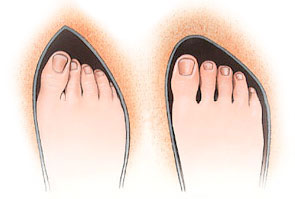 Are you singing the blues due to foot pain? Do you have an unsightly bump on the side of your foot at the base of your big toe? Is it red and inflamed? Does it cause you pain when your shoe rubs against it? If so, you may have a bunion.
Are you singing the blues due to foot pain? Do you have an unsightly bump on the side of your foot at the base of your big toe? Is it red and inflamed? Does it cause you pain when your shoe rubs against it? If so, you may have a bunion.
About 55% of American women suffer from bunions according to a study by the American Orthopaedic Foot and Ankle Society. Bunions are nine times more common in women than men. That’s not really surprising when you consider that women love wearing trendy shoes. And when you wear shoes that are too tight, too narrow, too pointed or too high, a bunion can be the result.
A bunion is an enlargement of the metatarsophalangeal (MTP) joint – the joint at the base of your big toe. When your big toe is bent or pushed up against your other toes (due to heredity or crowding caused by shoes that are too tight), a bony bump can form on the outer portion of your foot at the MTP joint. This bump is result of your MTP joint being moved out of alignment in the opposite direction of your big toe. Over time, if your bunion isn’t treated, this abnormal angle can cause your big toe joint to continue to get bigger until it’s very prominent and painful.
Smaller bunions, called bunionettes, can also form on the other side of your foot along the outside of your little toe joint, called the fifth metatarsophalangeal joint.
What are the symptoms of bunions?
Some of the common symptoms of bunions may include:
- Inflammation and redness at or near the base of your big toe joint.
- Constant or intermittent pain, which can make it uncomfortable to wear or walk in your shoes.
- Restricted or painful movement of the big toe.
- A burning sensation in the area.
- Possible numbness of the area.
Also, bunions can lead to the development of other foot conditions like corns, calluses, hammertoe and overlapping toes.
What are the treatment options for bunions?
In addition to stopping further joint deformity, the goals of treatment are to reduce the pressure on your bunion and, consequently, your pain. Treatment options will vary depending upon the type and severity of your bunion, but may include:
 Wearing properly fitted footwear – You should wear shoes with a wide and deep toe boxes that are comfortable on your feet. Avoid shoes with pointed toes or heels that are over two inches tall. Refer to our Shoe Fitting Guide for more information.
Wearing properly fitted footwear – You should wear shoes with a wide and deep toe boxes that are comfortable on your feet. Avoid shoes with pointed toes or heels that are over two inches tall. Refer to our Shoe Fitting Guide for more information.- Moleskin – You can place a moleskin or felt pad around the bunion to keep it from rubbing against your shoe.
- Ice – You can apply ice for 10 to 20 minutes to help reduce pain and inflammation.
- Medication – Non-prescription pain medications, like ibuprofen, may help to reduce pain and inflammation. Also, cortisone injections may be useful. However, these treatments usually only provide temporary relief.
- Orthotics – Custom orthotics, like ezWalker® Custom Performance Orthotics, can help relieve, and in some cases, eliminate pain while reducing the symptoms of bunions. The ezWalker® Custom Orthotic strategically supports your medial, lateral, and trans-metatarsal arches and helps to relieve pressure on the ball of your foot. Its biomechanical design enhances your foot’s position by supporting the hind foot, so it realigns the forefoot for the propulsion phase of the gait cycle. This redistributes pressure as you walk and helps to prevent the worsening of the deformity. Each ezWalker® Custom Orthotic is custom molded to the specifications of each of your feet, providing you with pain relief and comfort. These ultra-thin, ¾ length orthotics fit in a wide variety of shoes, too.
- Surgery – If conservative treatments, like those described above, don’t provide symptom relief, or if your deformity is severe, you may require a bunionectomy to remove the bony enlargement and realign the MTP joint.
With the proper treatment, you can find bunion pain relief. For more information about ezWalker® Performance Insoles, visit our website. Or, order your ezWalker Custom Orthotics today!
Because … when your feet feel good, you feel good. ®
Note: If you follow these guidelines and your pain persists, you may have a more serious condition. See your physician for a more complete diagnosis and treatment.

